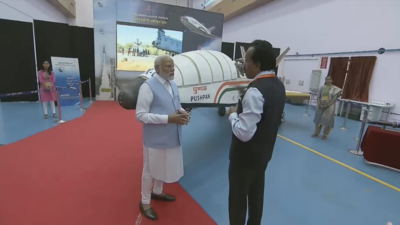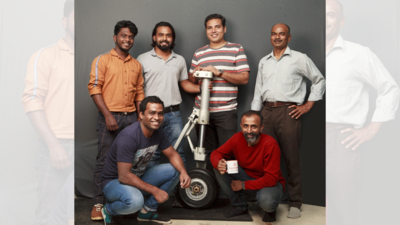- News
- India News
- RLV re-entry mission to use GSLV with PSLV last stage; landing gear to change & more
Trending
RLV re-entry mission to use GSLV with PSLV last stage; landing gear to change & more
BENGALURU: Isro, whose reusable launch vehicle (RLV) technology development programme has now entered a critical stage after the completion of the three landing experiments, will use a modified GSLV rocket to launch RLVs in the next phase of testing — orbital re-entry demonstration.
The orbital re-entry demonstration missions will involve vertical launching of the RLV into space and bringing it back safely to land on a runway.Isro may need to carry out multiple orbital re-entry tests and the RLV for these missions will be six times the size of the RLV technology demonstrator (RLV-TD) that the space agency has been using for testing so far.
The GSLV that will carry the scaled-up RLV, expected to weigh around 3.5 tonne to 4 tonne, to space will forego its cryogenic upper stage (CUS), which will be replaced by a rejigged version of the PS4 — the last stage of the trusted PSLV rocket.
S Unnikrishnan Nair, director, Vikram Sarabhai Space Centre (VSSC), which is spearheading the RLV programme, told TOI: “Although the overall size of the RLV will increase, the increase in mass won’t increase six times. Therefore, given the weight of the vehicle, we wouldn’t need the energy the GSLV can produce with the cryo stage, that’s why we are using the PS4.”
During re-entry, the belly of the vehicle needs to be shown to increase the drag and reduce the speed — that is, energy manoeuvring from orbit to touchdown.
Landing gear & large runway
Aside from modifications of thermal protection systems, enhanced software and NGC (navigation, guidance and control) and other sub-systems, the vehicle will need a different landing gear. For the prototype (RLV-TD), Isro had used a fixed landing gear supplied by Bengaluru-based Timetooth Technologies, which will have to be replaced by a deployable one.
And, Timetooth, which has supplied around five fixed landing gear systems for the programme so far, is optimistic of bagging the new order as well. The firm’s co-founder, Girish Mudgal, told TOI: “We are very optimistic. We’ve been working on a retractable version of the landing gear. We don’t know Isro’s exact plans for the orbital re-entry version, but we’ve built an extreme amount of trust and reputation for Isro to see us as a reliable partner for this programme.”
Other than Isro, Timetooth has supplied landing gears to DRDO as well. “...As far as we’re aware, we are India’s only company which has worked on the long endurance or large drones landing systems. We supplied our system for DRDO’s Rustom (now Tapas) drone, which had its maiden flight in 2016. And after that, there have been about over 200 flights,” Mudgal said.
Besides, Isro will also need to look for a larger runway to accommodate the landing of the orbital re-entry vehicle. And initially, it will have to rely on the Indian Air Force (IAF) to find a suitable runway.
“The landing site will have to be decided as it cannot happen in Chitradurga. We need a location that allows us to fly mostly over sea and requires minimal flying over land and populated areas. Flight over landmass must be minimal. We’ll have to discuss it with IAF,” Nair said.
The orbital re-entry demonstration missions will involve vertical launching of the RLV into space and bringing it back safely to land on a runway.Isro may need to carry out multiple orbital re-entry tests and the RLV for these missions will be six times the size of the RLV technology demonstrator (RLV-TD) that the space agency has been using for testing so far.
The GSLV that will carry the scaled-up RLV, expected to weigh around 3.5 tonne to 4 tonne, to space will forego its cryogenic upper stage (CUS), which will be replaced by a rejigged version of the PS4 — the last stage of the trusted PSLV rocket.
S Unnikrishnan Nair, director, Vikram Sarabhai Space Centre (VSSC), which is spearheading the RLV programme, told TOI: “Although the overall size of the RLV will increase, the increase in mass won’t increase six times. Therefore, given the weight of the vehicle, we wouldn’t need the energy the GSLV can produce with the cryo stage, that’s why we are using the PS4.”
The scaled-up RLV would also have enhanced thermal protection, which is crucial to prevent burning up of the vehicle during the re-entry phase. “Take off and landing are very critical for any aircraft. For us, take off will be vertical on the rocket. And for landing to be smooth, we’ll have to work on various systems that enable re-entry, approaching the runway, touching the correct place and aligning with the centre line, deployment of parachutes etc. The entire software will have to be written too,” Nair said.
During re-entry, the belly of the vehicle needs to be shown to increase the drag and reduce the speed — that is, energy manoeuvring from orbit to touchdown.
Landing gear & large runway
Aside from modifications of thermal protection systems, enhanced software and NGC (navigation, guidance and control) and other sub-systems, the vehicle will need a different landing gear. For the prototype (RLV-TD), Isro had used a fixed landing gear supplied by Bengaluru-based Timetooth Technologies, which will have to be replaced by a deployable one.
And, Timetooth, which has supplied around five fixed landing gear systems for the programme so far, is optimistic of bagging the new order as well. The firm’s co-founder, Girish Mudgal, told TOI: “We are very optimistic. We’ve been working on a retractable version of the landing gear. We don’t know Isro’s exact plans for the orbital re-entry version, but we’ve built an extreme amount of trust and reputation for Isro to see us as a reliable partner for this programme.”
Other than Isro, Timetooth has supplied landing gears to DRDO as well. “...As far as we’re aware, we are India’s only company which has worked on the long endurance or large drones landing systems. We supplied our system for DRDO’s Rustom (now Tapas) drone, which had its maiden flight in 2016. And after that, there have been about over 200 flights,” Mudgal said.
Besides, Isro will also need to look for a larger runway to accommodate the landing of the orbital re-entry vehicle. And initially, it will have to rely on the Indian Air Force (IAF) to find a suitable runway.
“The landing site will have to be decided as it cannot happen in Chitradurga. We need a location that allows us to fly mostly over sea and requires minimal flying over land and populated areas. Flight over landmass must be minimal. We’ll have to discuss it with IAF,” Nair said.
End of Article
FOLLOW US ON SOCIAL MEDIA













